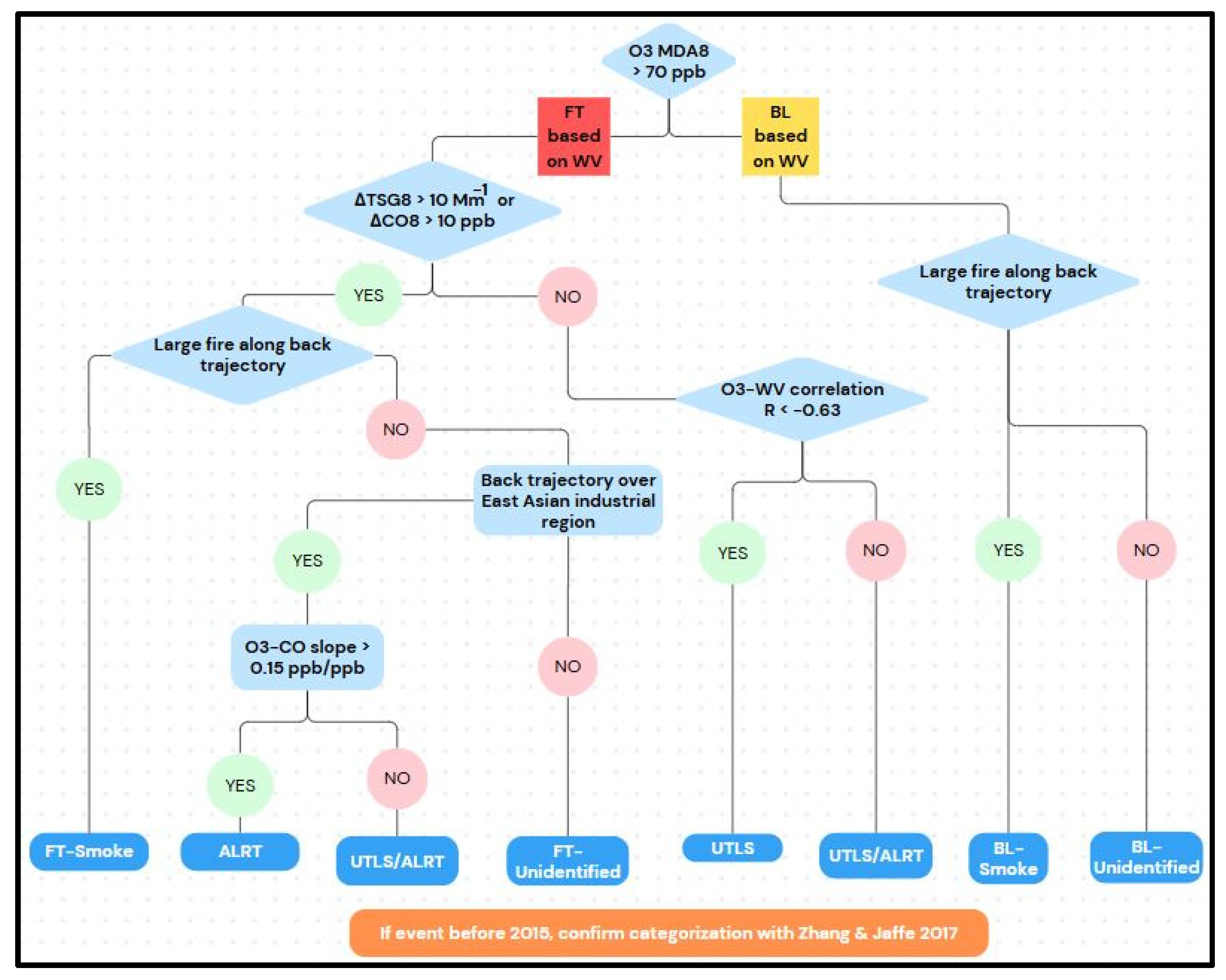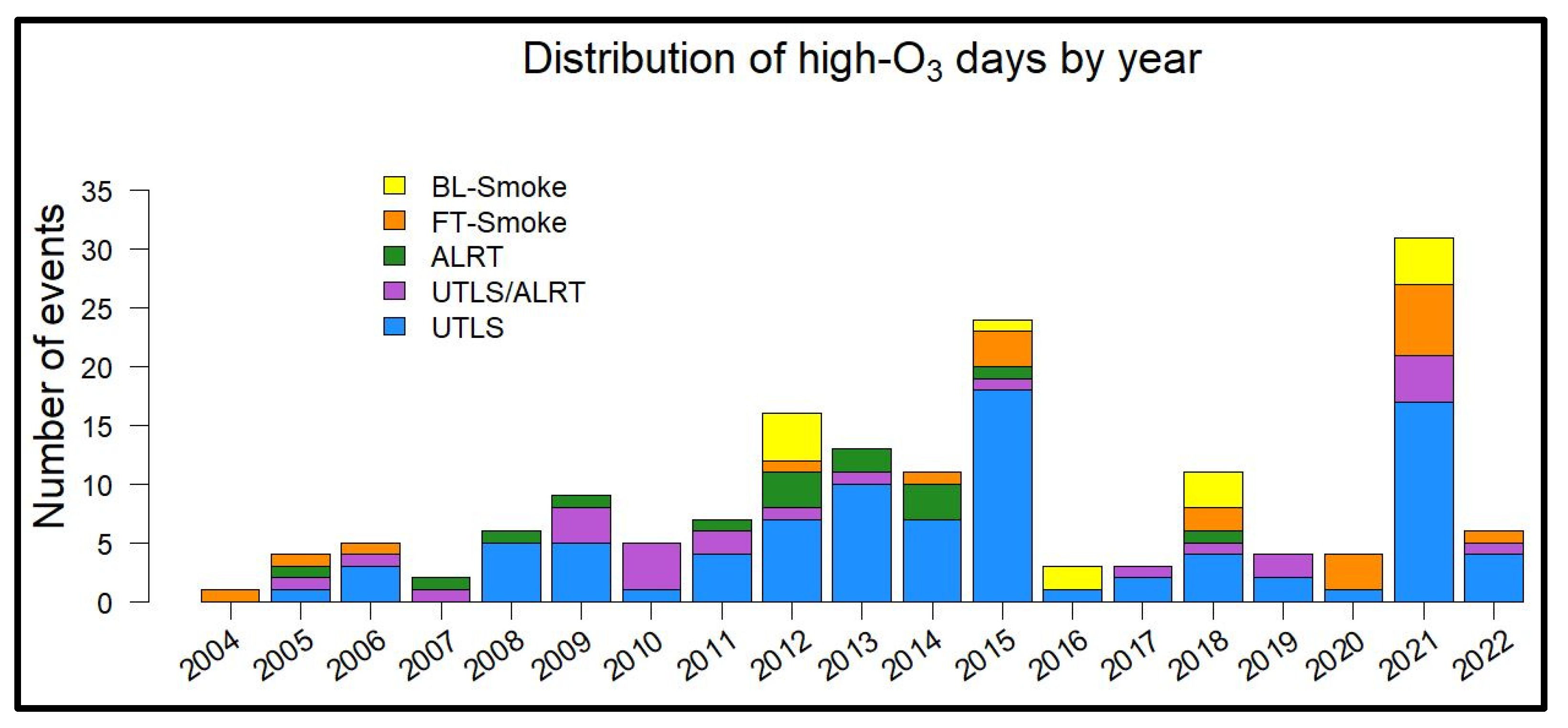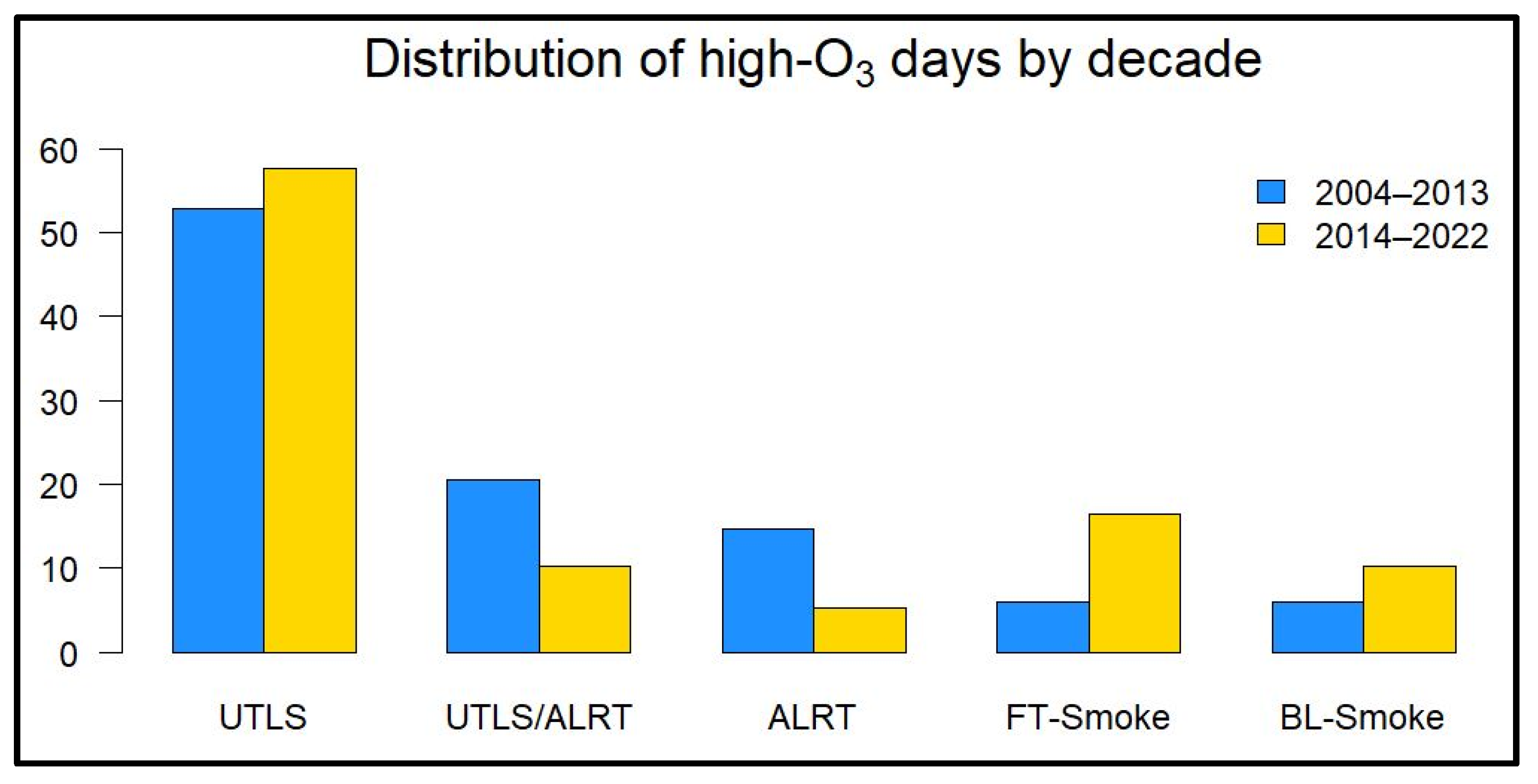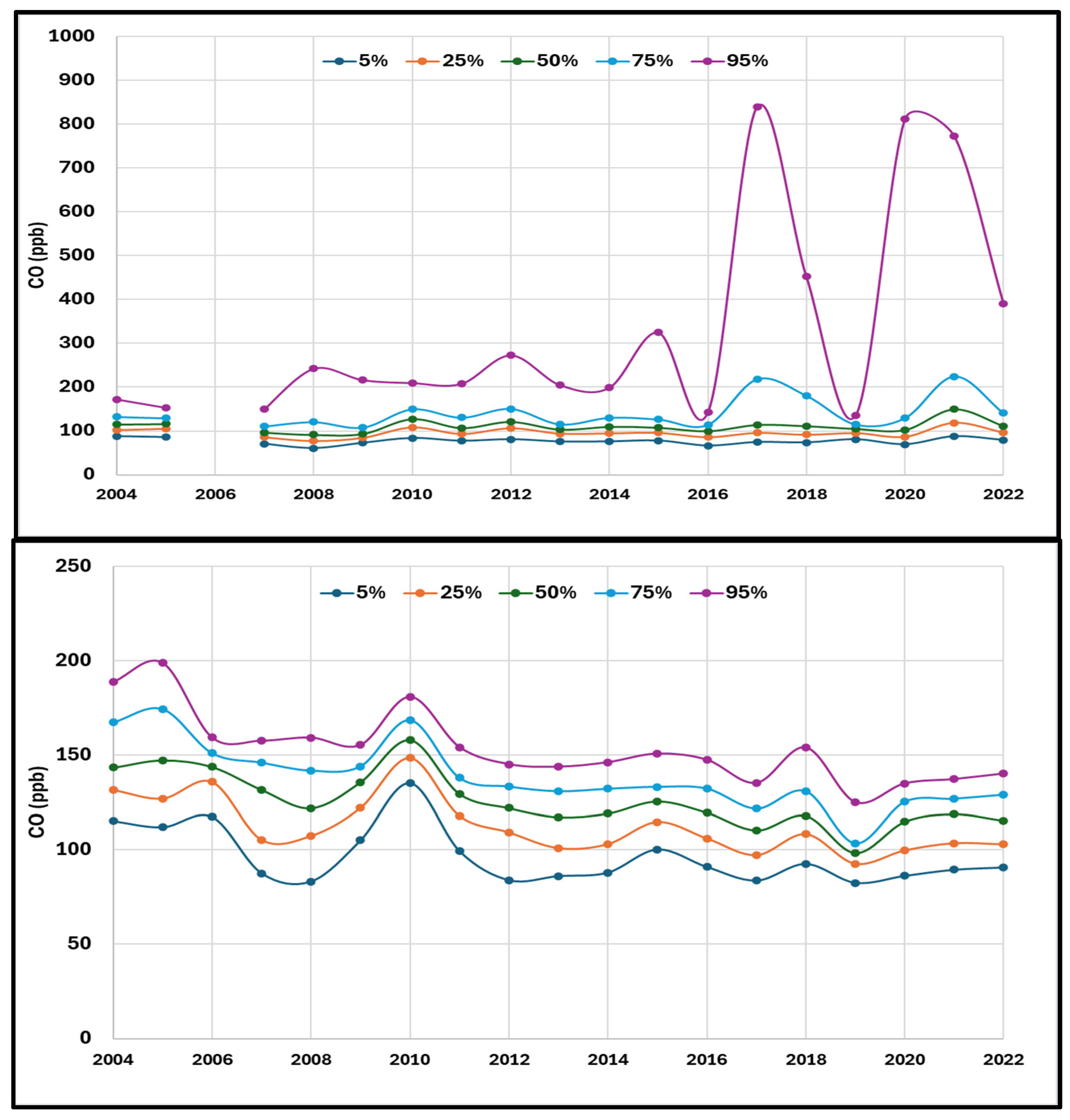Sources and Trends of CO, O3, and Aerosols at the Mount Bachelor Observatory (2004–2022)
Abstract
1. Introduction
2. Measurements and Other Sources of Data
3. Plume Identification and Trend Analysis Methodology
4. Results
5. Trends in O3 and CO
6. Discussion and Conclusions
Author Contributions
Funding
Institutional Review Board Statement
Informed Consent Statement
Data Availability Statement
Conflicts of Interest
References
- Intergovernmental Panel on Climate Change. Climate Change 2007: The Physical Science Basis; Solomon, S., Qin, D., Manning, A.L., Chen, B., Marquis, M., Averyt, K.B., Tignor, M., Miller, E.K., Eds.; Cambridge University Press: Cambridge, UK, 2007. [Google Scholar]
- Finlayson-Pitts, B.J.; Pitts, J.N. Atmospheric Chemistry: Fundamentals and Experimental Techniques; John Wiley and Sons: Hoboken, NJ, USA, 1986; ISBN 978-047-188-227-5. [Google Scholar]
- Simon, H.; Reff, A.; Wells, B.; Xing, J.; Frank, N. Ozone Trends Across the United States Over a Period of Decreasing NOx and VOC Emissions. Environ. Sci. Technol. 2015, 49, 186–195. [Google Scholar] [CrossRef] [PubMed]
- Bell, M.L.; McDermott, A.; Zeger, S.L.; Samet, J.M.; Dominici, F. Ozone and Short-Term Mortality in 95 US Urban Communities, 1987–2000. JAMA 2004, 292, 2372–2378. [Google Scholar] [CrossRef] [PubMed]
- Federal Register. National Ambient Air Quality Standards for Ozone. Available online: https://www.federalregister.gov/documents/2010/01/19/2010-340/national-ambient-air-quality-standards-for-ozone (accessed on 15 September 2024).
- Schultz, M.G.; Schröder, S.; Lyanpina, O.; Cooper, O.R.; Galbally, I.; Petropavlovskikh, I.; von Schneidemesser, E.; Tanimoto, H.; Elshorbany, Y.; Naja, M.; et al. Tropospheric Ozone Assessment Report: Database and Metrics Data of Global Surface Ozone Observations. Elem. Sci. Anthr. 2017, 5, 58. [Google Scholar] [CrossRef]
- Tarasick, D.; Galbally, I.E.; Cooper, O.R.; Schultz, M.G.; Ancellet, G.; Leblanc, T.; Wallington, T.J.; Ziemke, J.; Liu, X.; Steinbacher, M.; et al. Tropospheric Ozone Assessment Report: Tropospheric Ozone from 1877 to 2016, Observed Levels, Trends and Uncertainties. Elem. Sci. Anthr. 2019, 7, 39. [Google Scholar] [CrossRef]
- United Nations; Dentener, F.; Keating, T.; Akimoto, H. (Eds.) Hemispheric Transport of Air Pollution: Part A—Ozone and Particulate Matter; United Nations: Geneva, Switzerland, 2010; ISBN 978-921-054-109-1.
- Jaffe, D.A.; Cooper, O.R.; Fiore, A.M.; Henderson, B.H.; Tonnesen, G.S.; Russell, A.G.; Henze, D.K.; Langford, A.O.; Lin, M.; Moore, T. Scientific Assessment of Background Ozone Over the U.S.: Implications for Air Quality Management. Elem. Sci. Anthr. 2018, 6, 56. [Google Scholar] [CrossRef]
- Putero, D.; Cristofanelli, P.; Chang, K.-L.; Dufour, G.; Beachley, G.; Couret, C.; Effertz, P.; Jaffe, D.A.; Kubistin, D.; Lynch, J.; et al. Fingerprints of the COVID-19 Economic Downturn and Recovery on Ozone Anomalies at High-Elevation Sites in North America and Western Europe. Atmos. Chem. Phys. 2023, 23, 15693–15709. [Google Scholar] [CrossRef]
- Borhani, F.; Motlagh, M.S.; Stohl, A.; Rashidi, Y.; Ehsani, A.H. Tropospheric Ozone in Tehran, Iran, During the Last 20 Years. Environ. Geochem. Health 2022, 44, 3615–3637. [Google Scholar] [CrossRef]
- Zhao, Y.; Saunois, M.; Bousquet, P.; Lin, X.; Berchet, A.; Hegglin, M.I.; Canadell, J.G.; Jackson, R.B.; Deushi, M.; Jöckel, P.; et al. On the Role of Trend and Variability in the Hydroxyl Radical (OH) in the Global Methane Budget. Atmos. Chem. Phys. 2020, 20, 13011–13022. [Google Scholar] [CrossRef]
- Myhre, G.; Myhre, C.E.L.; Samset, B.H.; Storelvmo, T. Aerosols and their Relation to Global Climate and Climate Sensitivity. Nat. Educ. Knowl. 2013, 4, 1–8. [Google Scholar]
- Weiss-Penzias, P.; Jaffe, D.A.; Swartzendruber, P.; Dennison, J.B.; Chand, D.; Hafner, W.; Prestbo, E. Observations of Asian Air Pollution in the Free Troposphere at Mount Bachelor Observatory During the Spring of 2004. J. Geophys. Res. Atmos. 2006, 111, D10304. [Google Scholar] [CrossRef]
- Ambrose, J.L.; Reidmiller, D.R.; Jaffe, D.A. Cause of High O3 in the Lower Free Troposphere Over the Pacific Northwest as Observed at the Mt. Bachelor Observatory. Atmos. Environ. 2011, 45, 5302–5315. [Google Scholar] [CrossRef]
- Bourqui, M.S.; Trepanier, P.-Y. Descent of Deep Stratospheric Intrusions During the IONS August 2006 Campaign. J. Geophys. Res. Atmos. 2010, 115, D18301. [Google Scholar] [CrossRef]
- Lin, M.; Fiore, A.M.; Cooper, O.R.; Horowitz, L.W.; Langford, A.O.; Levy, H.; Johnson, B.J.; Naik, V.; Oltmans, S.J.; Senff, C.J. Springtime High Surface Ozone Events Over the Western United States: Quantifying the Role of Stratospheric Intrusions. J. Geophys. Res. Atmos. 2012, 117, D00V22. [Google Scholar] [CrossRef]
- Gratz, I.E.; Jaffe, D.A.; Hee, J.R. Causes of Increasing Ozone and Decreasing Carbon Monoxide in Springtime at the Mt. Bachelor Observatory from 2004 to 2013. Atmos. Environ. 2015, 109, 323–330. [Google Scholar] [CrossRef]
- Zhang, L.; Jaffe, D.A. Trends and Sources of Ozone and Sub-Micron Aerosols at the Mt. Bachelor Observatory (MBO) During 2004–2015. Atmos. Environ. 2017, 165, 143–154. [Google Scholar] [CrossRef]
- Jacob, D.J.; Wofsy, S.C.; Bakwin, P.S.; Fan, S.; Harriss, R.C.; Talbot, R.W.; Bradshaw, J.D.; Sandholm, S.T.; Singh, H.B.; Browell, E.V.; et al. Summertime Photochemistry of Troposphere at High Northern Latitudes. J. Geophys. Res. Atmos. 1992, 97, 16429. [Google Scholar] [CrossRef]
- van der A, R.J.; Mijling, A.B.; Ding, J.; Koukouli, M.E.; Liu, F.; Li, Q.; Mao, H.Q.; Theys, N. Cleaning up the Air: Effectiveness of Air Quality Policy for SO2 and NOx Emissions in China. Atmos. Chem. Phys. 2017, 17, 1775–1789. [Google Scholar] [CrossRef]
- Liu, F.; Beirle, S.; Zhang, Q.; van der A, R.J.; Zheng, B.; Tong, D.; He, K. NOx Emission Trends Over Chinese Cities Estimated from OMI Observations During 2005 to 2015. Atmos. Chem. Phys. 2017, 17, 9261–9275. [Google Scholar] [CrossRef]
- Hasunuma, H.; Ishimaru, Y.; Yoda, Y.; Shima, M. Decline of Ambient Air Pollution Levels Due to Measures to Control Automobile Emissions and Effects on the Prevalence of Respiratory and Allergic Disorders Among Children in Japan. Environ. Res. 2014, 131, 111–118. [Google Scholar] [CrossRef]
- Kim, Y.P.; Lee, G. Trend of Air Quality in Seoul: Policy and Science. Aerosol Air Qual. Res. 2018, 18, 2141–2156. [Google Scholar] [CrossRef]
- Park, J.; Shin, M.; Lee, J.; Lee, J. Estimating the Effectiveness of Vehicle Emission Regulations for Reducing NOx from Light-Duty Vehicles in Korea Using On-Road Measurements. Sci. Total Environ. 2021, 767, 144250. [Google Scholar] [CrossRef] [PubMed]
- Tang, L.; Qu, J.; Mi, Z.; Bo, X.; Chang, X.; Anadon, L.D.; Wang, S.; Xue, X.; Li, S.; Wang, X.; et al. Substantial Emissions Reductions from Chinese Power Plants After the Introduction of Ultra-Low Emissions Standards. Nat. Energy 2019, 4, 929–938. [Google Scholar] [CrossRef]
- Wang, N.; Lyu, X.; Deng, X.; Huang, X.; Jiang, F.; Ding, A. Aggravating O3 Pollution Due to NOx Emission Control in Eastern China. Sci. Total Environ. 2019, 677, 732–744. [Google Scholar] [CrossRef] [PubMed]
- Zhang, Q.; Zheng, Y.; Tong, D.; Hao, J. Drivers of Improved PM2.5 Air Quality in China 2013 to 2017. Proc. Natl. Acad. Sci. USA 2019, 116, 24463–24469. [Google Scholar] [CrossRef]
- Miyazaki, K.; Neu, J.; Osterman, G.; Bowman, K. Changes in US Background Ozone Associated with the 2011 Turnaround in Chinese NOx Emissions. Environ. Res. Commun. 2022, 4, 045003. [Google Scholar] [CrossRef]
- Bourgeois, I.; Peischl, J.; Neuman, J.A.; Brown, S.S.; Thompson, C.R.; Aikin, K.C.; Allen, H.M.; Angot, H.; Apel, E.C.; Baublitz, C.B.; et al. Large Contribution of Biomass Burning Emissions to Ozone Throughout the Global Remote Troposphere. Proc. Natl. Acad. Sci. USA 2021, 118, e2109628118. [Google Scholar] [CrossRef]
- Ziemke, J.R.; Chandra, S.; Duncan, B.N.; Schoeberl, M.R.; Torres, O.; Damon, M.R.; Bhartia, P.K. Recent Biomass Burning in the Tropics and Related Changes in Tropospheric Ozone. Geophys. Res. Lett. 2009, 36, L15819. [Google Scholar] [CrossRef]
- Gillett, N.P.; Weaver, A.J.; Zwiers, F.W.; Flannigan, M.D. Detecting the Effect of Climate Change on Canadian Forest Fires. Geophys. Res. Lett. 2004, 31, L18211. [Google Scholar] [CrossRef]
- Abatzoglou, J.T.; Williams, A.P. Impact of Anthropogenic Climate Change on Wildfire Across Western US Forests. Proc. Natl. Acad. Sci. USA 2016, 113, 11770–11775. [Google Scholar] [CrossRef]
- Westerling, A.L. Increasing Western US Forest Wildfire Activity: Sensitivity to Changes in the Timing of Spring. Philos. Trans. R. Soc. B Biol. Sci. 2016, 371, 20150178. [Google Scholar] [CrossRef]
- Spracklen, D.V.; Mickley, L.J.; Logan, J.A.; Hudman, R.C.; Yevich, R.; Flannigan, M.D.; Westerling, A.L. Impacts of Climate Change from 2000 to 2050 on Wildfire Activity and Carbonaceous Aerosol Concentrations in the Western United States. J. Geophys. Res. Atmos. 2009, 144, D20301. [Google Scholar] [CrossRef]
- Dahl, K.A.; Abatzoglou, J.T.; Phillips, C.A.; Ortiz-Partida, J.P.; Licker, R.; Merner, L.D.; Ekwurzel, B. Quantifying the Contribution of Major Carbon Producers to Increases in Vapor Pressure Deficit and Burned Area in Western US and Southwestern Canadian Forests. Environ. Res. Lett. 2023, 18, 064011. [Google Scholar] [CrossRef]
- Burke, M.; Childs, M.L.; de la Cuesta, B.; Qiu, M.; Li, J.; Gould, C.F.; Heft-Neal, S.; Wara, M. The Contribution of Wildfire to PM2.5 Trends in the USA. Nature 2023, 622, 761–766. [Google Scholar] [CrossRef] [PubMed]
- Marsavin, A.; von Gageldonk, R.; Bernays, N.; May, N.W.; Jaffe, D.A.; Fry, J.L. Optical Properties of Biomass Burning Aerosol During the 2021 Oregon Fire Season: Comparison Between Wild and Prescribed Fires. Environ. Sci. Atmos. 2023, 3, 608–616. [Google Scholar] [CrossRef]
- Anderson, T.L.; Ogren, J.A. Determining Aerosol Radiative Properties Using the TSI 3563 Integrating Nephelometer. Aerosol Sci. Technol. 1998, 29, 57–69. [Google Scholar] [CrossRef]
- Draxler, R.R.; Rolph, G.D. Hybrid Single-Particle Lagrangian Integrated Trajectory Model; NOAA Air Resources Laboratory: College Park, MD, USA. Available online: https://www.ready.noaa.gov/hypub-bin/trajtype.pl?runtype=archive (accessed on 15 September 2024).
- Kuroda, H.; Setou, T. Extensive Marine Heatwaves at the Sea Surface in the Northwestern Pacific Ocean in Summer 2021. Remote Sens. 2021, 13, 3989. [Google Scholar] [CrossRef]
- Dong, Z.; Wang, L.; Xu, P.; Cao, J.; Yang, R. Heatwaves Similar to the Unprecedented One in Summer 2021 Over Western North America are Projected to Become More Frequent in a Warmer World. Earth’s Future 2023, 11, e2022EF003437. [Google Scholar] [CrossRef]
- White, R.H.; Anderson, S.; Booth, J.F.; Braich, G.; Draeger, C.; Fei, C.; Harley, C.D.G.; Henderson, S.B.; Jakob, M.; Lau, C.-A.; et al. The Unprecedented Pacific Northwest Heatwave of June 2021. Nat. Commun. 2023, 14, 727. [Google Scholar] [CrossRef]
- National Interagency Fire Center. Statistics. Available online: https://www.nifc.gov/fire-information/statistics (accessed on 1 December 2024).
- Zheng, B.; Chevallier, F.; Yin, Y.; Ciais, P.; Fortems-Cheiney, A.; Deeter, M.N.; Parker, R.J.; Wang, Y.; Worden, H.M.; Zhao, Y. Global Atmospheric Carbon Monoxide Budget 2000–2017 Inferred from Multi-Species Atmospheric Inversions. Earth Syst. Sci. Data 2019, 11, 1411–1436. [Google Scholar] [CrossRef]
- Zheng, B.; Chevallier, F.; Ciais, P.; Yin, Y.; Deeter, M.; Worden, H.; Wang, Y.L.; Zhang, Q.; He, K.B. Rapid Decline in Carbon Monoxide Emissions and Export from East Asia Between Years 2005 and 2016. Environ. Res. Lett. 2018, 13, 044007. [Google Scholar] [CrossRef]








| Month | Monthly WV Cutoff (g/kg) |
|---|---|
| 1 | 3.26 |
| 2 | 2.64 |
| 3 | 2.46 |
| 4 | 2.55 |
| 5 | 3.06 |
| 6 | 4.25 |
| 7 | 5.14 |
| 8 | 5.23 |
| 9 | 4.60 |
| 10 | 4.36 |
| 11 | 3.44 |
| 12 | 2.97 |
| Winter | Spring | Summer | Fall | |||||||||||||||||
|---|---|---|---|---|---|---|---|---|---|---|---|---|---|---|---|---|---|---|---|---|
| Year | 5% | 25% | 50% | 75% | 95% | 5% | 25% | 50% | 75% | 95% | 5% | 25% | 50% | 75% | 95% | 5% | 25% | 50% | 75% | 95% |
| 2004 | 23.3 | 35.0 | 39.5 | 43.9 | 51.8 | 28.1 | 37.2 | 42.9 | 47.5 | 57.1 | 23.3 | 30.8 | 38.9 | 47.1 | 56.2 | 32.3 | 37.9 | 41.3 | 45.4 | 50.5 |
| 2005 | 35.6 | 43.2 | 46.4 | 50.0 | 56.3 | 33.3 | 41.0 | 46.1 | 50.7 | 58.9 | 29.3 | 39.7 | 46.6 | 52.6 | 61.8 | |||||
| 2006 | 43.4 | 46.0 | 47.9 | 49.9 | 53.8 | 30.1 | 40.8 | 48.3 | 54.2 | 66.3 | 25.6 | 36.7 | 46.2 | 53.1 | 65.1 | |||||
| 2007 | 32.4 | 39.0 | 42.8 | 46.6 | 54.4 | 29.5 | 38.2 | 44.4 | 51.6 | 63.2 | 26.8 | 34.5 | 41.9 | 48.9 | 57.5 | 24.0 | 35.4 | 39.9 | 46.2 | 55.9 |
| 2008 | 25.8 | 40.4 | 46.3 | 50.8 | 59.2 | 33.6 | 43.3 | 49.5 | 55.9 | 65.5 | 21.6 | 33.9 | 44.1 | 50.1 | 63.9 | 23.5 | 34.2 | 38.6 | 44.3 | 50.3 |
| 2009 | 34.4 | 40.0 | 44.3 | 47.8 | 55.1 | 30.3 | 41.7 | 47.9 | 53.9 | 65.2 | 28.4 | 37.1 | 45.1 | 50.4 | 62.5 | 25.5 | 32.0 | 37.1 | 43.1 | 50.1 |
| 2010 | 22.1 | 26.8 | 29.7 | 36.2 | 62.3 | 28.6 | 42.2 | 49.9 | 57.3 | 64.4 | 30.3 | 39.8 | 47.0 | 52.2 | 62.1 | 18.8 | 28.4 | 37.0 | 43.3 | 51.2 |
| 2011 | 27.5 | 39.3 | 43.9 | 48.1 | 53.5 | 33.3 | 43.0 | 48.2 | 53.9 | 65.0 | 24.1 | 32.5 | 39.7 | 47.6 | 57.4 | 29.0 | 38.0 | 42.2 | 46.4 | 53.7 |
| 2012 | 31.7 | 39.8 | 44.8 | 48.8 | 55.9 | 33.6 | 44.7 | 51.1 | 59.9 | 71.5 | 37.3 | 46.8 | 53.0 | 59.5 | 69.4 | 28.1 | 39.0 | 42.6 | 45.9 | 54.1 |
| 2013 | 38.6 | 43.9 | 47.1 | 50.3 | 57.1 | 30.0 | 39.8 | 48.1 | 55.7 | 69.0 | 30.9 | 39.9 | 47.0 | 52.6 | 62.1 | 37.3 | 42.6 | 47.2 | 51.5 | 59.2 |
| 2014 | 37.5 | 42.4 | 45.3 | 48.7 | 57.8 | 31.5 | 41.3 | 47.2 | 54.0 | 65.5 | 30.1 | 43.2 | 49.3 | 55.1 | 67.2 | 36.8 | 41.2 | 44.0 | 47.1 | 52.2 |
| 2015 | 38.9 | 43.7 | 48.4 | 52.5 | 58.7 | 43.1 | 50.8 | 55.3 | 61.3 | 72.7 | 35.6 | 43.3 | 50.0 | 56.8 | 66.7 | 37.4 | 42.4 | 45.5 | 50.3 | 57.0 |
| 2016 | 35.4 | 40.1 | 42.9 | 45.5 | 50.7 | 31.8 | 39.9 | 47.0 | 54.2 | 63.6 | 28.6 | 37.7 | 44.6 | 51.7 | 63.7 | 33.6 | 42.5 | 45.8 | 49.0 | 54.8 |
| 2017 | 31.3 | 41.0 | 44.5 | 48.0 | 53.7 | 31.9 | 43.2 | 48.1 | 52.7 | 64.8 | 23.1 | 36.6 | 43.5 | 49.2 | 67.8 | |||||
| 2018 | 42.2 | 45.5 | 47.4 | 49.8 | 53.9 | 35.5 | 44.0 | 48.7 | 54.0 | 65.5 | 30.7 | 39.2 | 46.6 | 54.8 | 66.8 | 31.3 | 38.1 | 41.8 | 46.2 | 55.4 |
| 2019 | 38.3 | 42.7 | 46.3 | 50.1 | 54.7 | 31.5 | 39.6 | 46.6 | 54.2 | 66.6 | 24.1 | 32.4 | 37.7 | 43.8 | 54.8 | 30.2 | 36.1 | 41.0 | 47.0 | 55.3 |
| 2020 | 21.4 | 29.1 | 34.5 | 39.6 | 48.5 | 22.5 | 30.5 | 37.2 | 46.1 | 65.7 | 29.2 | 39.3 | 44.5 | 49.5 | 56.3 | |||||
| 2021 | 35.5 | 46.2 | 50.6 | 55.8 | 66.3 | 34.5 | 43.5 | 47.8 | 53.9 | 66.1 | 35.0 | 45.7 | 54.7 | 63.5 | 81.5 | 30.0 | 37.6 | 41.0 | 45.6 | 54.9 |
| 2022 | 38.7 | 45.0 | 49.7 | 53.3 | 60.1 | 35.2 | 41.7 | 46.7 | 50.6 | 59.1 | 35.3 | 42.3 | 48.1 | 54.9 | 63.8 | 31.2 | 36.0 | 39.6 | 43.0 | 48.1 |
| Winter | Spring | Summer | Fall | |||||||||||||||||
|---|---|---|---|---|---|---|---|---|---|---|---|---|---|---|---|---|---|---|---|---|
| Year | 5% | 25% | 50% | 75% | 95% | 5% | 25% | 50% | 75% | 95% | 5% | 25% | 50% | 75% | 95% | 5% | 25% | 50% | 75% | 95% |
| 2004 | 158.0 | 164.6 | 169.8 | 173.6 | 180.4 | 115.2 | 131.6 | 143.4 | 167.3 | 188.8 | 87.8 | 102.0 | 115.0 | 132.3 | 172.3 | 97.9 | 116.3 | 129.1 | 144.1 | 166.3 |
| 2005 | 123.5 | 142.8 | 151.9 | 163.5 | 181.8 | 112.0 | 127.1 | 147.3 | 174.3 | 199.0 | 85.7 | 105.1 | 116.0 | 129.2 | 153.2 | |||||
| 2006 | 87.4 | 95.7 | 100.7 | 108.3 | 149.9 | 117.4 | 135.8 | 143.8 | 151.0 | 159.3 | 80.6 | 90.4 | 100.8 | 109.7 | 130.3 | |||||
| 2007 | 107.3 | 121.8 | 129.8 | 138.2 | 152.8 | 87.6 | 105.2 | 131.7 | 146.0 | 157.6 | 70.6 | 85.9 | 96.6 | 110.5 | 149.6 | 89.2 | 101.1 | 111.7 | 122.1 | 136.8 |
| 2008 | 98.5 | 112.8 | 121.3 | 131.5 | 145.8 | 83.2 | 107.3 | 122.0 | 141.8 | 159.3 | 60.7 | 77.4 | 91.3 | 120.5 | 242.0 | 74.9 | 91.0 | 103.3 | 116.5 | 133.2 |
| 2009 | 90.9 | 113.3 | 128.3 | 137.8 | 152.2 | 105.0 | 122.1 | 135.7 | 144.1 | 155.4 | 72.8 | 84.5 | 93.6 | 108.2 | 216.1 | |||||
| 2010 | 112.4 | 132.8 | 145.4 | 159.6 | 181.9 | 135.4 | 148.5 | 158.0 | 168.5 | 181.0 | 83.7 | 108.1 | 127.2 | 149.6 | 209.5 | |||||
| 2011 | 118.7 | 133.4 | 139.8 | 145.7 | 156.0 | 99.4 | 117.9 | 129.5 | 137.9 | 154.2 | 77.4 | 93.3 | 107.0 | 130.6 | 207.8 | 98.5 | 115.4 | 125.2 | 133.4 | 148.9 |
| 2012 | 83.9 | 109.2 | 122.0 | 133.3 | 145.2 | 80.9 | 106.2 | 120.9 | 150.5 | 272.7 | 89.6 | 105.0 | 114.3 | 124.9 | 135.8 | |||||
| 2013 | 104.4 | 119.2 | 126.0 | 140.4 | 149.9 | 86.1 | 100.9 | 117.3 | 130.9 | 143.8 | 75.7 | 94.2 | 103.6 | 115.4 | 204.8 | 85.6 | 94.9 | 103.6 | 112.5 | 128.2 |
| 2014 | 93.1 | 107.2 | 121.0 | 136.4 | 154.1 | 87.9 | 103.0 | 119.2 | 132.2 | 146.2 | 75.9 | 94.6 | 109.7 | 130.3 | 198.9 | 90.6 | 104.4 | 111.9 | 120.3 | 134.4 |
| 2015 | 87.0 | 103.4 | 118.5 | 129.0 | 142.8 | 100.2 | 114.7 | 125.6 | 133.2 | 150.8 | 77.9 | 95.7 | 107.7 | 126.5 | 324.5 | 89.4 | 98.3 | 107.2 | 115.5 | 141.9 |
| 2016 | 90.9 | 106.1 | 119.6 | 132.3 | 147.5 | 66.5 | 86.1 | 99.9 | 114.4 | 142.7 | 88.8 | 107.7 | 119.6 | 130.4 | 147.9 | |||||
| 2017 | 83.7 | 97.2 | 110.3 | 121.7 | 135.2 | 74.5 | 95.7 | 114.1 | 217.7 | 839.7 | 110.0 | 110.6 | 111.8 | 112.2 | 114.2 | |||||
| 2018 | 114.3 | 125.3 | 133.0 | 140.7 | 147.1 | 92.5 | 108.3 | 118.0 | 130.9 | 154.1 | 73.6 | 91.4 | 111.2 | 180.1 | 451.9 | 89.5 | 100.8 | 110.4 | 117.9 | 128.6 |
| 2019 | 103.1 | 115.2 | 125.0 | 132.0 | 142.8 | 82.5 | 92.7 | 98.4 | 103.4 | 125.0 | 80.8 | 95.3 | 105.1 | 115.0 | 136.2 | 85.2 | 97.3 | 105.1 | 110.3 | 115.0 |
| 2020 | 109.1 | 117.0 | 121.4 | 125.7 | 134.5 | 86.2 | 99.7 | 114.9 | 125.4 | 135.0 | 69.6 | 86.9 | 102.6 | 129.8 | 811.7 | 79.6 | 102.2 | 114.5 | 122.6 | 148.3 |
| 2021 | 105.3 | 120.4 | 127.7 | 134.7 | 149.0 | 89.4 | 103.5 | 118.9 | 126.9 | 137.3 | 87.7 | 118.7 | 149.4 | 224.1 | 772.5 | 92.3 | 108.1 | 119.5 | 127.7 | 136.9 |
| 2022 | 104.3 | 114.8 | 120.9 | 129.8 | 140.4 | 90.6 | 102.9 | 115.4 | 129.1 | 140.2 | 79.2 | 96.5 | 111.5 | 140.7 | 390.1 | 87.2 | 97.3 | 104.8 | 111.7 | 133.0 |
Disclaimer/Publisher’s Note: The statements, opinions and data contained in all publications are solely those of the individual author(s) and contributor(s) and not of MDPI and/or the editor(s). MDPI and/or the editor(s) disclaim responsibility for any injury to people or property resulting from any ideas, methods, instructions or products referred to in the content. |
© 2025 by the authors. Licensee MDPI, Basel, Switzerland. This article is an open access article distributed under the terms and conditions of the Creative Commons Attribution (CC BY) license (https://creativecommons.org/licenses/by/4.0/).
Share and Cite
Bernays, N.; Johnson, J.; Jaffe, D. Sources and Trends of CO, O3, and Aerosols at the Mount Bachelor Observatory (2004–2022). Atmosphere 2025, 16, 85. https://doi.org/10.3390/atmos16010085
Bernays N, Johnson J, Jaffe D. Sources and Trends of CO, O3, and Aerosols at the Mount Bachelor Observatory (2004–2022). Atmosphere. 2025; 16(1):85. https://doi.org/10.3390/atmos16010085
Chicago/Turabian StyleBernays, Noah, Jakob Johnson, and Daniel Jaffe. 2025. "Sources and Trends of CO, O3, and Aerosols at the Mount Bachelor Observatory (2004–2022)" Atmosphere 16, no. 1: 85. https://doi.org/10.3390/atmos16010085
APA StyleBernays, N., Johnson, J., & Jaffe, D. (2025). Sources and Trends of CO, O3, and Aerosols at the Mount Bachelor Observatory (2004–2022). Atmosphere, 16(1), 85. https://doi.org/10.3390/atmos16010085






